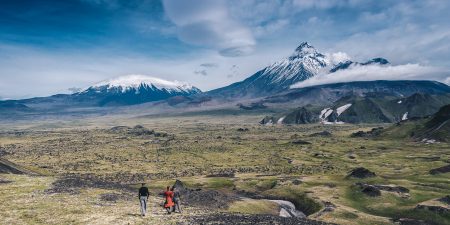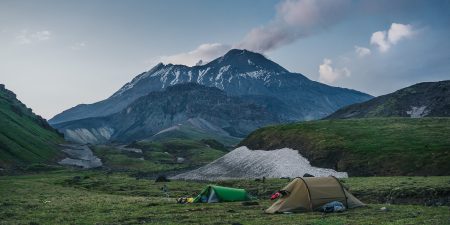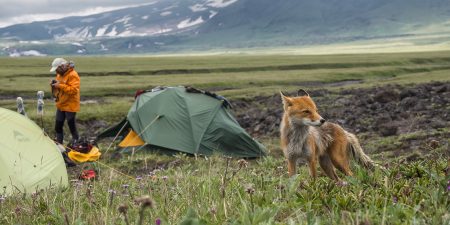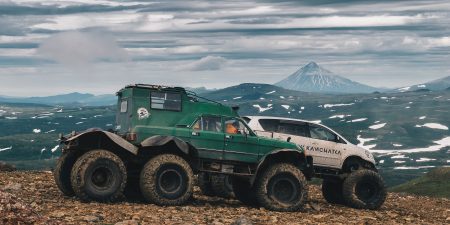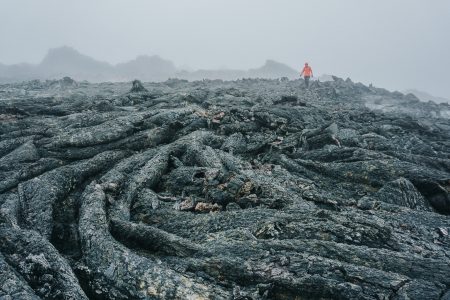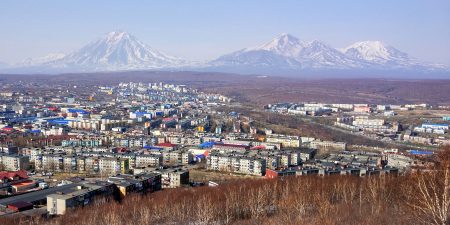€1540
excl. of flights
ON HOLD.
Moderate, 120km over 10 days
min 7 participants
Daily +5-20 °C, can be wet & windy
Witness surreal volcanic landscapes at the heart of a UNESCO World Heritage national park in Kamchatka — a Russian peninsula that is closer to Alaska than the nearest Russian city. The 14-day itinerary is tailored for keen trekkers and lovers of wild camping among active volcanoes! It also includes a day sea cruise with observing marine wildlife.
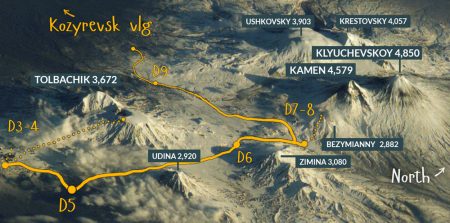
Am I fit enough for self-contained trekking?
The total length of the self-contained section of the trek is about 62 kilometers done over 5 days. Yet unlike hut-to-hut trekking common in Europe and Nepal, our trip involves wild camping, mostly on pristine alpine meadows above the treeline. Remaining self-contained allows for more tranquility and enables a more intimate connection with nature. This also means no lodges, no showers and no maintained trails for up to 8 days. We may spend days – or even the entire trek – without seeing any other humans.
7,000 km by air.
Grab a window seat to catch a fleeting glimpse of the volcanoes, as your 8-hour non-stop flight from Moscow approaches the Pacific coast of Kamchatka. With clear skies, you can see the ‘home’ volcanoes towering above the airstrip right when you step outside the plane.
The airport is tiny, with only a few daily arrivals. On the first day, we will be based in the small town of Elizovo close to the airport. A 15-minute drive takes us to our apartments where we can relax after the long flight.
It is possible to go for a short walk around the town. The more stoic jet lag warriors can soak in hot springs which are just 40 minutes away by taxi, at a small extra cost. In the evening the team gathers together for a short briefing and gear check, followed by a friendly, home-cooked dinner.
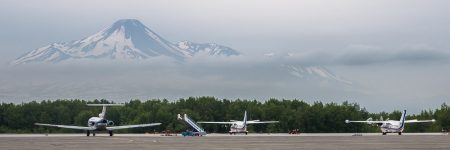
550 km by car.
Good things come to those who wait. Today we embark on a 7-hours drive up north along the peninsula’s main road, largely unpaved, traditionally stopping for sweet and savoury pies in a small town midway. In the late afternoon, we arrive in the archetypical village of Kozyrevsk, where we stay for the night in traditional wooden cabins. A real Russian steam bath cleans the body and mind, invigorating you for for the upcoming adventure.
About 80 km by 6WD truck.
We set out early on a military truck (6×6 or 4×4 depending on the team size), wading through the thicket of taiga forest up towards the barren volcanic plateau south of Tolbachik volcano, at about 1,300 m above the sea level. Back in 2015 lava flows of Tolbachik cut across the old access road several times but the locals quickly improvised a detour. After about five hours of the bumpy ride, the wood abruptly ends and our heavy-duty vehicle escapes into the vast desert of black volcanic ash stretching beyond the horizon.
The landscape at the foothills of Tolbachik is literally otherworldly. In 1969 it even served as a natural test site for the first Soviet lunar rover. Yet today it is not uncommon to see vibrant alpine flowers bursting through the ash.
We drive south through the volcanic desert to explore the epicentre of the 1975 great fissure eruption of Tolbachik, which came largely unknown to the Western world due to restricted access to the remote Soviet peninsula of Kamchatka. Back then only a few volcanologists witnessed the eruption column several kilometers high blazing from a rift in the Earth’s crust and the cloud of ash rising into the stratosphere, while inexorable lava flows burned life for many miles. A straight chain of smaller volcanic cones emerged along the rift.
We climb one of the cones to the top where we get to feel the inner heat of the Earth escaping through cracks in the ground. The temperature is so high that a wooden stick gets charcoaled in a few minutes. At another spot further south, we visit natural caves formed by receding lava and, by contrast, it is quite cool inside, in the middle of July.
Later on, we make a brief stop at the ‘dead forest’ – a stretch of dry fir trees destroyed by the ash fall – a silent uncanny evidence of the natural disaster, along with an abandoned helicopter tail cemented into the ground nearby.
In the evening we pitch our tents at Tolbachik basecamp which boasts a few communal huts with a kitchen. This allows us to have a gratifying dinner and rest well before the summit attempt tomorrow.
24 km roundtrip without packs, gaining and dropping about 1700 meters.
It is time for the mountaineering part of our adventure! After about 4-5 hours of following the uphill trail, which usually has short sections of snow even in July, we crest the crater rim at over 3000 meters above sea level. The mouth of the crater is over one kilometer across and is so deep that it could easily fit the Eiffel tower. With that sort of scale, it is easy to visualize indigenous legends about Kamchatka mountain spirits who used their fingers as skewers to grill whole whales on top of volcanoes! The locals believed that there were heaps of whale bones on the mountaintops – but never dared to check it out.
We ramble around the glacial summit plateau for about an hour and take in the view of the surrounding volcanoes that soar above the sea of clouds and endless taiga forest.
On the way back we stop at the most recent lava fields of the 2013 eruption where you can still feel warm ground! En route we will visit two lava caves, one of them is sauna-hot inside and has sulphur stalactites hanging off the ceiling!
10 km, gaining 270 m and dropping 640 m.
The day begins with a quick crossing of the chaotic jumble of the recently solidified lava flow. The crossing is only possible at a specific narrow spot. To the side of us, the ground is still steaming! As we move away from the volcano, sprouts of grass start bursting through the ashes and the lifeless black desert gradually gives way to green rolling hills and alpine meadows.
Our final destination for the day is a rustic cabin built at the bend of a narrow brook. Originally built by geologists, it is now primarily used by tourists as a safe place to stay in the bear country which starts here, just below the treeline.
17 km, gaining 550 m and dropping 120 m.
Leaving the hut, we ascend the gentle slope of Tolud col along the pebbled stream bed. Once past the highest point, we effortlessly continue traversing the pristine steppe-like valley sandwiched between Tolbachik, Udina and Zimina volcanoes.
We pitch our tents by the west flank of Ovalnaya Zimina volcano, next to a pool filled with meltwater from numerous snowfields. This is the ideal spot to marvel at the perfect ebony cone of Klyuchevskaya sopka – the highest active volcano of the continent, its formidable Matterhorn-like neighbour Kamen (‘The Stone’), the jagged ever-smouldering ruins of Bezymianny volcano and the snow-capped dome of Ushkovsky. Hopefully, the afternoon clouds sitting on top of the volcanoes will fade away, leaving us with gorgeous sunset views.
Upon return to our tents, we discover that the intricate network of underground lava tunnels in a nearby hill is home to several colonies of marmots and ground squirrels. The ones standing at the lookout whistle loudly as you approach but their comrades never miss out on scrounging those yummy tidbits right from your tent – have your camera ready! The impudence is understandable as they compete for survival in this harsh environment with scrawny foxes and odd brown bears, which occasionally stray here from the lowlands abundant in spawning salmon.
11 km, gaining about 400 m.
In the morning we cross into the northern dale of Tolbachik. A breathtaking panorama opens on the other side: a somewhat spooky view of numerous terracotta deposits resembling UFO landing sites amongst the green grass crisscrossed with streaks of black ash.
Oddly shaped pumice formations protrude through the soil here and there. We pass a small extinct volcanic cone ‘Jupiter’, whilst a prominent basalt pinnacle nearby is aptly named ‘Mars’.
We then cross another pass and camp near a volcanologists’ cabin at the foothills of the active Bezymianny volcano.
18km trekking with packs, gaining about 150m.
We head west and cross Bezymianny pass. The grassy plains are interspersed with old lava outcrops, while marmots and ground squirrels seem to hail us from everywhere. It is always fascinating to observe nature recovering from prehistoric eruptions!
As we come closer to Studenaya (‘Chilly’) river it becomes clear why we had to start the day early to ensure the water level stays low. The current is still strong and we may spend some time finding the shallowest place where the river branches most.
Once we dry our feet, we keep trekking along the river until it suddenly dives underground into a grey basalt canyon about 300 meters long and up to 20 meters deep. If we arrive early enough it will still be possible to walk inside and listen to the creepy echoes of our voices! In July there may still be snow patches forming a leaking roof.
At the end of the long day, we reach the ‘Edelweiss meadow’ campsite with a shed organised by the national park. There is a small waterfall nearby and the place is teeming with tame ground squirrels.
8 km, gaining 250 and dropping 320 m.
Our trekking is almost over yet there is still a fascinating morning hike to do without packs. The narrow trail brings us straight to the dramatic striated cliffs soaring above the river, which dives deeply into its basalt bed down below, while the opposite side of the valley is dominated by the imposing Tolbachik volcano.
Back at the campsite, we pick our packs, climb up the cliff along a well-trodden path back to the grassy plains and follow a faint vehicle trek to the national park’s hut where our all-terrain car picks us up. The ride back to Kozyrevsk is much shorter than what we endured on the way in and soon we are greeted by our friendly local host.
Some 70 km by boat.
Early in the morning we head straight to the port to experience Kamchatka and its wildlife from the seaside! A comfortable boat takes us out to Avacha bay, one of the largest natural bays in the world. We sail by the legendary ‘Three Brothers’ rocks – a magnificent symbol of the city and a mascot of local sailors.
We exit the bay and venture into the open ocean aiming at a tiny Starichkov island located about 30 kilometers south of the city. Rising steeply up to 140 meters above the sea its shores are home to multiple colonies of countless marine birds, mainly ancient murrelets (the islet is named after them in Russian!) and puffins but also red-faced cormorants, guillemots and seagulls. Often it is possible to spot fur seals lazing on the coastal reefs and if we a lucky we may even catch a glimpse of an orca (killer whale)!
Weather-permitting, we will take turns using an inflatable motorboat to draw closer to the island. Those remaining on the boat can try their hand at sea fishing with the most common catch being plaice, halibut, sea perch, greenling and cod. At the same time, a professional diver will fetch sea urchins, sea stars or even crabs from the ocean floor. In a short time piping hot seafood will be waiting for us, complemented with a tasting of sea urchin caviar!
The entire trip takes about 6-7 hours which seems to pass all too quickly!
Back in the city, we visit a somewhat old-fashioned Kamchatka regional museum of local lore which houses thousands of authentic exhibits illustrating the life of indigenous tribes and the discovery of the peninsula by the Russians back in the XVIII century.
About 170 km by a monster truck or 6WD and roughly 6 km on foot.
After 5-6 hours of riding a formidable monster truck, we pass by Russia’s only geothermal power plant and then walk into the caldera of the Mutnovsky volcano. This place feels like one of the planet’s energy nodes where its raw untamed energy comes out in the form of sulfur vents, roaring like jet engines, steaming hot streams and bubbling mud. The downside of the show, of course, is the acrid smell of rotten eggs!
The heat of the Earth melts glaciers in the caldera, giving birth to a wild stream that cuts through colourful layers of volcanic sediments and abruptly ends in a dramatic 80m high waterfall. On the way back we stop at one of the numerous hot springs which are a delight to soak in after our adventure. We then have a friendly farewell dinner at one of the city restaurants.
In the morning, before going to the airport, we can stock up with souvenirs, smoked fish, crab and caviar – this all will easily last for a few days to impress your friends and family back home!
We can help organize your stopovers in Moscow and/or Saint-Petersburg, provide recommendations on sightseeing and time your visa accordingly.
Why Kamchatka?
There is something very special about volcanoes. When you stand next to one, you can’t help feeling that humanity is merely an overgrown colony of primates blithely riding through space on a paper-thin crust of a molten lava ball. There are few places on Earth where this sudden insight is amplified with awe due to the proximity of the roaring ocean and encounters with abundant wildlife.
One such place is Kamchatka – a remote peninsula the size of the UK at the final frontier of Russia, where the Eurasian continent is washed by the cold Pacific, nine hours ahead of Moscow and geographically closer to Alaska than the nearest major Russian city.
Six areas on the peninsula are protected as UNESCO World Heritage sites, thanks to a unique combination of volcanoes, glaciers, hot springs and geysers which altogether forge landscapes of stunning beauty and dramatic contrasts. Extremely low population density and minimal urban development help diverse flora and fauna remain largely undisturbed.
We offer to join a trek through a remote area with some of the highest volcanoes of Kamchatka dominated by Klyuchevskoy, which at 4,750m is the largest active volcano in the Northern Hemisphere. Designed for true explorers, the itinerary combines immersion into pristine nature through responsible wild camping and easy self-contained trekking with a taster of mountaineering.
Your guides
Andrew Golovachev, an IFMGA aspirant ski guide within the guides’ association of Kyrgyzstan, an avid alpine climber, and devoted adventure photographer.
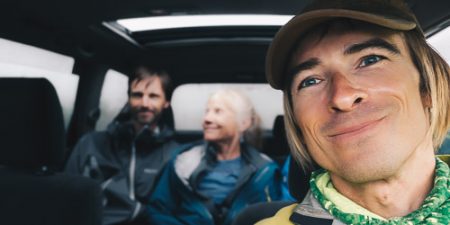
Ran treks, climbs, ski tours and expeditions to Tajikistan Pamirs, Patagonia, Peru, Morocco, Nepal, Kyrgyzstan, Kazakhstan, Siberia, Caucasus and Kamchatka. A full member of the British Alpine Club. Professional avalanche education: equivalent of Canadian Avalanche Association Level 1 certificate.
Visited over 40 countries, lived in the UK for four years. Certified first-aider.
Booking terms
Sounds exciting? It truly is! We love the place and would be happy to share it with you. Should you have any questions, please check out our FAQ section below. Alternatively, don’t hesitate to send us your inquiry using the contact form or WhatsApp.
We require financial commitment from participants in the form of two deposits made via bank transfer or Paypal. The first deposit of €140 is made immediately to secure your place. Part of this amount goes towards furnishing the Russian visa invitation and other administration costs. The second deposit of €580 must be made no later than two months before the trip so we could pre-book the logistics with the local operators. To save on bank fees you might prefer a single deposit of €720 instead. The remaining balance is paid in cash upon arrival.
Cancellation policy
If you need to cancel your trip 60 days or less before departure because you are prevented from travelling due to:
1) a government banning non-essential travel to the destination or imposing a quarantine for vaccinated upon arrival upon return from the destination country, or
2) a national or local lockdown
We will put your deposits in full towards a future trip with us, this year or the next year.
The above does not apply in the following cases:
– You or a family member is diagnosed with Covid and you are required to self-isolate, which prevents you from travelling.
– A close relative is diagnosed with Covid and you are required to care for them.
– You are denied boarding to your flight due to failing Covid checks.
– You are unable to join your trip due to not fully complying with the testing or vaccination requirements to enter the destination country.
We strongly recommend taking out a travel insurance with specific Covid-19 cancellation and curtailment provision which is now available from many reputable providers.
We also promise a 14-day risk-free booking window: you can cancel at any point within two weeks after you put down the first deposit. This buys you time to sort out vacation and flights, to bring in your friends, etc. and not have to worry about someone else taking your spot on the trip.
In case of cancellation of the trip by the participant due to any other personal circumstances any deposits made are NOT refunded. At our sole discretion we may put them towards your future trips with us.
The minimum group size for this trip is 7 participants plus the guide. Should there be less, the trip will be cancelled and all deposits made will be returned in full.
Start Your Journey
Got a question or ready to plan your adventure? Drop us a line using the form below — we’ll reply within 24 hours!
Prefer email? Reach out at hello@primalscapes.com
We promise no spam — just answers. Your info stays safe with us and won’t be shared.
Our COVID-19 commitment
The pandemic brought out the importance of staying away from the crowds which you are welcome to do at any of our trips! Driven by the best practices of the Adventure Travel Trade Association (ATTA), we at Primalscapes commit to the following:
— If you can’t travel due to a travel ban then we put your deposits towards a future trip with us. More details in our Cancellation Policy.
— We gather together small groups of 4-8 participants. Alternatively, why not book a bespoke trip just for you and your friends?
— These days health and safety is a shared responsibility so we ask our participants to provide COVID-19 test certificates right before the trip. Our guides and trek leaders are also tested.
— We provide private transfers throughout, avoiding congested locations.
— We include pulse oximeter and thermometer into our first medical kit for better chances of accurate diagnostics in the field. Should we mention hand sanitizers?
— On the ‘sail to ski’ trip, the boat is thoroughly disinfected before the trip. High-use areas are disinfected on a daily basis. Interactions with the crew are kept to a minimum: they sleep in a separate compartment and dine at different times.
Extra excursions
We also can book you on the following optional daytrips that come at an extra cost – please enquire!
Rafting along Bystraya river where we can observe spawning salmon and there is a high probability of brown bear sightings. If you are serious about fishing we recommend taking 2-day rafting instead.
A heli trip to the valley of Geysers, a UNESCO Heritage site and the world’s second-largest geyser field that rivals Yosemite! After spending 1.5 hours in the valley (a geyser sighting is guaranteed!) the next stop is at the mind-blowing caldera of Uzon volcano with its colorful moonscapes of steaming vents and bubbling mud painted by thermophilic algae and microorganisms. The last stop is at Nalychevo national park where you can soak in natural hot springs. The trip also includes a flyby of Karymsky and Maly Semyachik active volcanoes, the latter featuring a bright turquoise acidic lake inside its crater.
A trip to a stylized indigenous village, witnessing traditional colourful dances and tasting authentic dishes. On the way back, there is a stop at relaxing hot springs.
Finally, if that is your first time in Russia, it makes perfect sense to stop in Moscow and Saint-Petersburg for a few days on the way back. We can provide recommendations on sightseeing and extend your visa accordingly.



